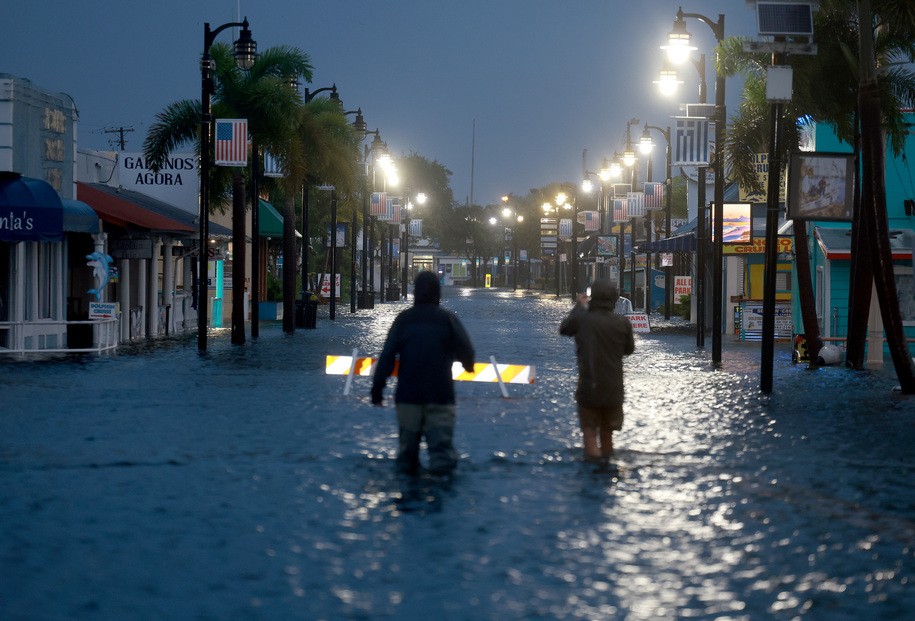39 million U.S. properties are overvalued because of climate-related risks
from Daily Kos
Report: Nearly 40 million U.S. properties are overvalued because of climate-related risks
by Meteor Bladed, Daily Kos Staff Emeritus | September 20, 2023< A new report from the First Street Foundation released Wednesday has found that 39 million U.S. properties are overvalued because damage risks from climate change as a result of flooding, hurricanes, and wildfires ““have yet to be reflected in the insurance premiums.” The largest percentage of those properties—60%—are coastal properties at risk from hurricanes, 30% are vulnerable to flooding, and 10% are in wildfire zones.
The foundation’s latest report, “The Climate Insurance Bubble,” says the properties are “likely overvalued due to the underpricing or subsidization of climate risk in their insurance.”
“It has the potential to impact property values in a way that’s similar to what we saw in the last recession in 2008,” First Street CEO Matthew Eby said in an interview.
Other reports have estimated property overvaluation before, but those have tended to focus on either a specific region or a particular type of hazard such as flooding. The First Street report appears to be the first to analyze the entire nation and the combined effect of three kinds of disasters — flooding, wildfires and hurricane winds — on property values.
The report notes that insurance rates have been on the rise but frequently not enough to cover damage in events caused or exacerbated by climate change. The researchers note:
However, regulations in places such as California, Florida, and Louisiana have suppressed insurance prices for years. As a result, the insurance industry is limiting and withdrawing coverage in high-risk wildfire areas due to state regulatory policies, increasing risk from climate change, and recent economic shifts.
In some cases, this will lead to homeowners foregoing insurance while in all cases, the value of their property will be impacted as the cost of ownership increases with rising premiums. These dynamics are visible in some areas of the country where rates are increasing, and private insurance companies are effectively labeling areas as uninsurable, with state-backed “insurers of last resort” becoming the only option for many homeowners. Without the ability to insure properties in high risk areas with relatively affordable policies, homeowners will not be able to afford the cost of ownership associated with homes in those areas and property values will deflate, leading to a realization of the current climate-driven overvaluation in the market.
For example, in the case of windstorm insurance, the state-sponsored “last resort” option has become the largest such insurer in Florida. Since 2016, the policies under this program have risen by 168% to over 1.3 million, and the average premium has increased 61% from about $2,000 to about $3,300. Matthew Eby, First Street’s executive director, told Bloomberg Green, “The over-reliance of property owners on the state-run insurers of last resort is a big flashing sign that standard practices in the insurance market cannot keep up with our current climate reality.”

Republican lawmakers at federal and state levels have been fighting against requiring companies to fully disclose their greenhouse gas emissions, the financial risks related to climate change, and what they are doing to reduce both. Not new, of course. The previous governor of Florida banned even mentioning the term “climate change” in state agency documents, and the current governor banned Florida cities and towns from adopting 100% clean energy goals on the grounds that this discriminates against fossil fuels. Such idiocy isn’t confined to the Sunshine State, of course.
But, while Republicans in power can force government agencies not to account for climate-related risks to health, life, and finances while pushing policies designed to keep the fossil fuel industry alive until every last drop of oil, molecule of natural gas, and lump of coal are extracted, they cannot force insurance companies to ignore climate risk in pricing policies. As those risks grow, more and more insurers will walk away from high-risk areas to salvage their bottom lines. Allstate, American Family, Nationwide, Erie Insurance Group, and Berkshire Hathaway have stopped issuing policies and are raising premiums and deductibles in some regions because of climate change risks.
“We’re in the business of pricing to risk,” Matt Mayrl, vice president of strategy, performance and partnerships at American Family Insurance, said in an interview with The Washington Post. “Sometimes your price can’t match your risk.”
Jacob Bogage reports:
Major insurers say they will cut out damage caused by hurricanes, wind and hail from policies underwriting property along coastlines and in wildfire country, according to a voluntary survey conducted by the National Association of Insurance Commissioners, a group of state officials who regulate rates and policy forms.
Insurance providers are also more willing to drop existing policies in some locales as they become more vulnerable to natural disasters. Most home insurance coverages are annual terms, so providers are not bound to them for more than one year.
That means individuals and families in places once considered safe from natural catastrophes could lose crucial insurance protections while their natural disaster exposure expands or intensifies as global temperatures rise.
There was another just-released report—Changing Climate for the Insurance Sector. Conducted by Ceres, ERM, and Persefoni, it notes that the top 16 insurance firms held more than 50% of the $536 billion in fossil fuel-related assets of the insurance sector even in 2019, the last year for which we have complete data. This as many of these same insurers raised premiums and dropped property coverage within certain high climate-related risk regions.
There will be no relief until serious action is taken nationwide to deal with the roots of this situation. Soaring insurance premiums and dropped coverage are just another climate-related symptom. Besides eliminating greenhouse gas emissions, new construction needs to be blocked in the most vulnerable areas. As has become clear, more and more areas “once considered safe” are going to be added to the list of those that aren’t.

